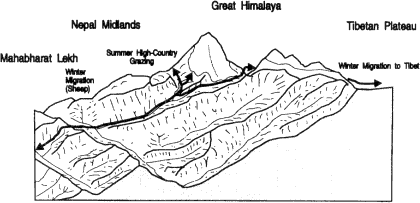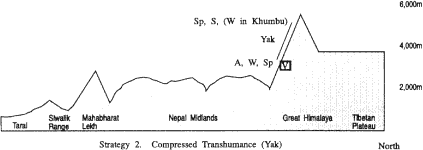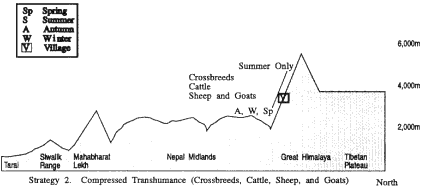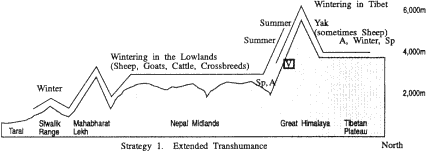High-Altitude Mountain Agropastoralism
Above 3,000 meters life is different for the high-altitude-dwelling peoples who make the high valleys of the Great Himalaya and trans-Himalaya their home.[16] At these altitudes crops can only be produced during the summer and generally there is not time enough in the short growing season to cultivate more than a single crop per year of a small number of plants fit for high altitude. The cool temperatures and the risks of late spring, early autumn, and even summer frosts restrict the range of staple crops to barley, buckwheat, wheat, and tubers. Rice, maize, and millet cannot be cultivated and at higher altitudes even wheat production is not possible. Pastoralism is similarly limited in options. The climate is too difficult for water buffalo and cattle may be kept year round at such heights only if much effort is made to stable them and provide them with fodder through the winter months. But yak, yak-cattle crossbreeds, sheep and goats all thrive. Figures 4 and 5 show the geographical and altitudinal land-use patterns associated with variations of the high-altitude mountain agropastoral strategy. As with the middle-altitude agropastoral strategy both extended and compressed strategies are depicted. Extended strategies make greater use of seasonal transhumance, either across the Himalaya to Tibet for winter herding of yak and sheep, down-valley winter herding of sheep, goats, and cattle in the midlands or even the Tarai, or a combination of both of these. The compressed pattern relies on year-round use of the resources of the Great Himalaya alone.
For the past century, and very likely for long before that, peoples following high-altitude agropastoral strategies have usually relied on trade to supplement their crop production. Trade for lower-altitude-grown grains has been particularly important. Until the 1960s many families devoted much of their winter to trading trips to the south in order to barter Tibetan salt and other goods for grain and take advantage of the warmer weather, the readily available food, and the good grazing. Sheep and goats were often taken on these winter journeys as pack animals, whereas families who kept yak left them with herding specialists in the high valleys or sent them across the mountains to Tibet, where the grazing is often better in winter than on the south side of the Himalayan crest



Figure 4.
High-Altitude Agropastoralism, Geographic Patterns (Base drawing
adapted from Metz 1989)
since there is less snow and yak can find abundant grazing on the vast pastures. This way of life, however, is today no longer followed by many Bhotia groups. Political and economic changes in Tibet following the onset of Chinese administration after 1959 have greatly affected trade conditions for Bhotias, as did the 1962 war between China and India and its diplomatic aftermath. Some groups of Bhotias have been unable to continue trans-Himalayan trade on the old scale or to winter stock in Tibet. This has led to major changes in life for Bhotia peoples (see, for example, Fürer-Haimendorf 1975; Rauber 1982). Some have abandoned their former subsistence strategies and migration from the high country and other high-altitude peoples have developed new types of trade or become involved in the tourism industry.
Transhumance is an important feature of the high-altitude agropastoral strategy. After the crops are planted and well established in the main villages families follow the good grass into the upper valleys. Yak and sheep may be herded in mid- and late summer as high as 6,000 meters. Herders usually live in tents, often the black yak-hair tents familiar also in Tibet, moving through a series of different camps in a long-established routine modified to meet the pasture and weather conditions of the particular year. Sometimes additional fields are also cultivated in the summer herding settlements where fine crops of potatoes and barley can be grown even as high as 4,300 meters. Families who continue to trade with Tibet dovetail the demands of the agricultural cycle with one or more trips across the border during the period between spring and late autumn to obtain salt, borax, wool, and other goods for their winter trading in the south.

Figure 5.
High-Altitude Agropastoralism, Altitudinal Patterns
Only a few Sherpa groups follow a high-altitude mountain agropastoral strategy, the best known of which are the Sherpas of Khumbu and Rolwaling. The narrow valley of Rolwaling, seven kilometers in length and never more than one kilometer wide, is comparable in altitude to Khumbu. The main village, Beding, is situated at 3,600 meters. Fewer than fifty households inhabit the valley and they prac-
tice a mixed agropastoralism emphasizing transhumant yak herding and multialtitudinal crop production of potatoes and barley. Potatoes and barley are grown as high as the settlement of Na at 4,100 meters. Yak are herded in the summer to above 5,000 meters (Sacherer 1981:157-158). Khumbu Sherpa subsistence strategies are discussed later in this chapter.